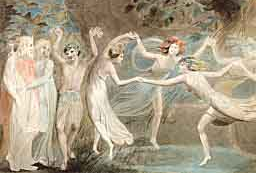On 3 November, 2015, the Centre welcomed Lizanne Henderson (Glasgow) to discuss ‘Fairies, Angels and the Land of the Dead: Robert Kirk’s Lychnobious People’. Below is this listener’s brief summary of the lecture.
Lizanne explained that understanding belief systems during any time period is difficult because beliefs differed depending on the individual. Her work focuses on the thoughts and beliefs of Reverend Robert Kirk, a minister of Balquhidder in 1664 and then Aberfoyle in 1685. Through her study of Kirk’s work, The Secret Commonwealth of Elves, Fauns and Fairies, one can get an idea of how fairies and the dead were viewed in the 17th century.

In several sources, fairies are often associated with the dead or themes of death. In Gaelic tradition, fairies are referred to as sluagh (people, folk; multitude; host; army), sluagh-sith (fairy-host), sluagh na marbh (host of the dead), and sluagh eutrom (by Donald A MacKenzie as “light, airy, gay, or giddy folk”). Various other themes tied the dead and fairies together, including stories involving small hillocks (‘fairy hills’), food taboos, green clothing, and certain times of the year when the spirit world was thought to be closer to our world, including Beltane.
Reverend Robert Kirk appears to have been very interested in both fairies and ‘second sight’, a gift often associated with seventh sons (Robert Kirk was a seventh son himself, although he never outright claimed to have the second sight). The Secret of the Commonwealth explains his conceptions about the soul, supernatural communication, and connections between fairies and death. He relied on evidence from Biblical sources and oral testimony from his parishioners who had encountered fairies. Lizanne explained that his work also showed that, in addition to the Bible, he was heavily influenced by Neo-Platonism and Classical philosophy.
One of the primary reasons Kirk wrote The Secret of the Commonwealth was to prove the existence of fairies. He believed that by gathering evidence of fairies, this would uphold belief in angels, demons, the Devil and the Holy Spirit. He saw his work as the first step in the fight against the growing threat of atheism.
Kirk’s description of the lychnobious people (“those living by lamplight”) appears to have been built on the framework provided by those who had studied angels. Much like Sir Thomas Aquinas, who divided angels into a hierarchy of three orders, and Pseudo-Dionysius the Areopagite, who divided them into nine, Kirk divided fairies into nine tribes and described their political structure and society. While they were described as similar in several ways, including physical description, there were also many differences between angels and fairies. Fairies married and pro-created, while angels did not. Angels were sent by God to help humanity, while Kirk described fairies as non-Christian and ambivalent towards humans. He viewed them as a subterranean species somewhere between angels and humans that could be seen by those with second sight.
Lizanne explained that Kirk saw the fairies as an intelligent species that was closely associated with the dead, it is unlikely that Kirk ever saw them as the same. She believes that Kirk saw fairies as “guardians” of human souls; mounds adjacent to churchyards and fairy hills were often thought to have housed the souls of ancestors. It is uncertain whether Kirk’s worldview reflects those beliefs widely held by others in the 17th century; further study could offer additional insight into the matter.
Summary by Megan Kasten (PhD researcher)
Our seminar series continues on 10 November 2015 with Alex Woolf (St. Andrews) discussing ‘Ecclesia Scoticana: The Irish and Scottish Church in the tenth to twelfth centuries‘. This will be held in Room 202, 3 University Gardens at 5.30pm.

